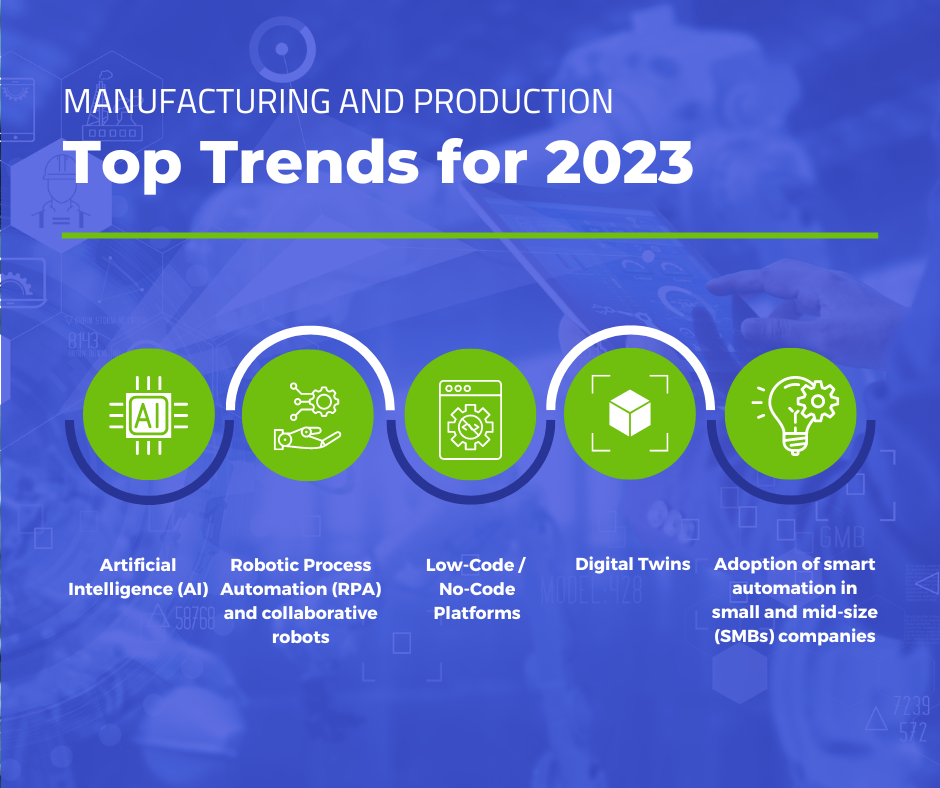
The pandemic shock, the shortage in IT and software development skills and the mitigation of supply chain risk will drive industrial automation for manufacturing and production companies in 2023 and beyond.
Precedence Research predicts that the market for global industrial automation will grow from $196,6 billion up to $412,8 billion in 2030 more than 200%.
Artificial Intelligence (AI)
With AI algorithms manufacturing companies will implement more and more machine learning methods. These methods will learn from existing data (text, audio, images) and will create new content. Depending on new and slightly different use cases. This will speed up the development and make the production more flexible.
Robotic Process Automation (RPA) and collaborative robots
RPA has become an important piece in manufacturing automation as it enables software bots to replicate human actions and tasks.
Together with collaborative robots also known as “cohorts” which are interacting with humans in a shared production environment for example in warehouses moving heavy weights or changing, moving assembly lines. These technologies help increase efficiency in small and mid-size companies.
Low-Code/No-Code Platforms
These platforms are providing applications and software programs with little or even no coding experience and bringing a new level of agility, flexibility and speed into the development of manufacturing and production solutions. Especially under the new paradigm of “Composable Manufacturing solution” which allows the companies to compose their specific solution out of a set of different applications and components based on individual needs and requirements Low-/No-Code platforms are a “must-have”.
Digital Twins
Another major trend will be the Digital Twin of production and robotics in manufacturing processes. A digital Twin is a virtual representation of a real-world process or entity. But it is not only a digital version of a real-world production process it gets continuous real-time updates on all material and behavior similar to the physical twin gets.
The Digital Twin concept is already quite established in the Product Lifecycle Management (PLM) area. In the area of Manufacturing Execution Systems (MES) Digital Twins will help to monitor the process, assessing areas of risk and help with predictive maintenance approaches.
Adoption of smart automation in small and mid-size (SMBs) companies
Finally, new technologies like No-/Low-Code Platforms, Digital Twins and AI, and RPI make it much easier for SMBs to adopt digital technologies to their manufacturing solutions to reduce costs, improve customer services and gain competitiveness.
What is the impact of these trends on companies in 2023?
The trends described above will have an impact on the following challenges manufacturing companies are faced next year and beyond.
The different crises have shown the vulnerability of globalization with their supply chains.
We also see a bottleneck of qualified IT and software developers.
Overall companies must be more agile, flexible, and proactive in the way they produce, automate and build products to be competitive in these global markets.
Summarized the major trends for 2023 will have an impact on the following challenges for companies:
- Mitigate supply chain risk
- Managing and overcoming the bottleneck of talents – special in the area of IT and software development
- Drive forward the Digitalization and automatization of manufacturing and production to reduce cost and gain a competitive advantage
- Use of Digitalization and automatization potential also for small and mid-size companies, not only for the big companies
- Bring agility and flexibility into manufacturing and production
How NC-Vision can help drive Industrial Automation
Built from the ground up on a true no-code foundation, NC-Vision empowers production and manufacturing companies to take control: Visualize what’s going on on the shopfloor – anywhere, anytime, creating your unique digital twin.
Get real-time insights into processes, machines, and resources to support data-driven decisions and increase business efficiency.
Adapt with Ease
Respond to new products, variants, regulations and guidelines. Improvise effectively when things have to move fast.
Implement Fast
Go live in days instead of months with your individual composition. Add plug & play solutions from the marketplace later.
Bring Down Costs
Avoid lengthy project planning and overpriced customizing, while keeping operating costs in check.
Conclusion
It is important not only for big companies but also for SMEs to speed up the Digitalization of their manufacturing and production.
Moving out of the pandemic and the recession the investments into manufacturing automation, especially in Europe need to grow to win back competitive advantages against Asia and North America.
This is a “must-have” to manage the bottleneck of talents, mitigate supply chain risk and be more agile and flexible in manufacturing and production.












